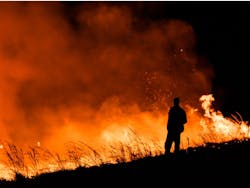PG&E Power Outages Could Jump under Judge’s Proposal. But is PSPS Even Needed?
A federal judge is considering requiring California utility Pacific Gas & Electric (PG&E) to change its criteria for instituting public safety power shutoffs (PSPS) in a way that is expected to sharply increase the number of planned power outages across the utility’s service territory.
California’s investor-owned utilities cut off power in high-risk situations to prevent utility equipment from starting wildfires. Last year, PG&E instituted six shutoffs, which cut power to 653,100 customers.
The shutoffs have spurred interest in microgrids in California and led the California Public Utilities Commission (CPUC) to take steps to speed up microgrid development.
In response to a finding that the deadly Zogg Fire in September was caused by a tree slated for removal, US District Judge William Alsup said he may require that PG&E include local tree hazards in its criteria to determine whether to institute a PSPS.
Alsup, who oversees the utility’s criminal probation, said that his proposal would increase shutoffs 67% — from 27 to 45 incidences over a decade.
The judge’s proposal would also increase the average length of the outages to 28 hours, up from 23 hours, and affect about 342,000 people per event, up from 317,000 people, according to the utility.
Places such as Butte, Yuba, Nevada, Placer and Sierra counties would see planned outages roughly double from current expectations.
As suggested by Judge Alsup, PG&E plans to use data related to the possibility trees could fall on power lines in calling PSPS events, according to a March 29 letter from the utility to the judge.
CPUC balks at expanded PSPS criteria
The CPUC warned Alsup not to intrude on the commission’s authority to oversee electric utilities and said that the judge’s proposal would “dramatically expand the scope” of the shutoffs and lead to unnecessary hardships for utility customers.
“PSPS is a vital wildfire prevention and mitigation tool that electric utilities can use, but PSPS itself raises serious public safety consequences by potentially impairing emergency services, water pumping capability and communications infrastructure,” the CPUC said.
The CPUC, which plans a fast-track review of PG&E’s plan to include tree data in its process for instituting PSPS, will consider the adequacy of existing mitigation measures and new mitigation measures to address public safety perils caused by expanding the number of planned outages. “Most importantly, the CPUC’s process will enable vital and integral stakeholders to provide input on all aspects of the proposal,” the commission said.
The commission plans to hold a workshop on PG&E’s plan this month so the state agency can review the proposal ahead of the wildfire season.
Is PSPS focus misplaced?
Given that utility equipment is responsible for a small fraction of the wildfires that burn across California each year, the intense focus on the planned power shutoffs is misplaced, according to Catherine Von Burg, the CEO and co-founder of SimpliPhi Power, an energy storage company based in Oxnard, California.
“There seems to be this framing of a really serious public safety, public health issue around utilities being responsive to help combat wildfires by shutting off the grid — which causes enormous hardship and economic fallout,” Von Burg said in an interview. “Why isn’t there a call to action around climate change, the fundamental underlying causes of wildfires?”
Von Burg also sees hardening an aging grid, with its centralized fossil-fueled power plants, as a misplaced effort.
While planned power outages may have some effect in limiting wildfires, a better approach would be to focus on distributed resources, according to Von Burg.
However, utilities in California and across the US fight interconnection requests, making it harder for customers to install distributed resources, she said.
“They should be investing in customer-sited storage. Put in a couple batteries across homes, and they can identify what their critical loads are, and they have power through hours, days, or the weeks that these power outages have lasted,” Von Burg said.
Learn about real-world microgrids that kept the power flowing during wildfires, storms, grid malfunctions and other disasters — and what it meant to the businesses, institutions and communities they serve — at Microgrid 2021 in a special session, “Microgrids as Reliability Heroes,” 11 am, May 11. Participation is free if you register in advance. Space on the virtual platform is limited.
Distributed assets also help offset the economic losses that outages can cause, such as spoiled food, according to Von Burg.
Strong customer interest exists in energy storage, Von Burg added. Despite the uncertainty created by the coronavirus pandemic, demand for SimpliPhi’s energy storage products jumped 40% last year, she said.
“It was almost this perfect storm with COVID. People realized they’re vulnerable because they cannot rely on top down centralized distribution systems.” The wariness about centralized systems stems from failures in delivery of personal protective equipment, food, water and, now, power, according to Von Burg.
Batteries allow people to store power in homes, schools and clinics and use it when needed.
“It was really during COVID that we saw this rapid increase in demand for customer-sited energy storage to create that security,” she said.
Track news about California. microgrids. Subscribe to the free Microgrid Knowledge Newsletter.
